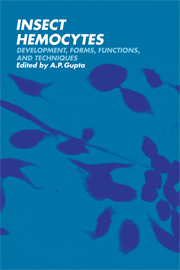Book contents
- Frontmatter
- Contents
- Preface
- List of contributors
- Part I Development and differentiation
- Part II Forms and structure
- Part III Functions
- 11 Hemocytes and growth in insects
- 12 Hemocytes and connective tissue: a critical assessment
- 13 Role of hemocytes in defense against biological agents
- 14 Cellular and humoral responses to toxic substances
- 15 Biochemical and ultrastructural aspects of synthesis, storage, and secretion in hemocytes
- 16 Changes in hemocyte populations
- Part IV Techniques
- Indexes
12 - Hemocytes and connective tissue: a critical assessment
Published online by Cambridge University Press: 04 August 2010
- Frontmatter
- Contents
- Preface
- List of contributors
- Part I Development and differentiation
- Part II Forms and structure
- Part III Functions
- 11 Hemocytes and growth in insects
- 12 Hemocytes and connective tissue: a critical assessment
- 13 Role of hemocytes in defense against biological agents
- 14 Cellular and humoral responses to toxic substances
- 15 Biochemical and ultrastructural aspects of synthesis, storage, and secretion in hemocytes
- 16 Changes in hemocyte populations
- Part IV Techniques
- Indexes
Summary
Introduction
There has been much speculation in the past about the possible role of hemocytes in the production of the connective tissues in insects. At the time hemocytes were first implicated (Lazarenko, 1925; Wermel, 1938), our knowledge of insect connective tissues was rudimentary. It is only since 1955 that information about the biochemistry and fine structure of these tissues has accumulated.
Before insect connective tissues and the hemocytes are discussed in more detail, it is pertinent to consider current concepts about connective tissues in other animals, especially those of mammals and birds. Any notion that these are irrelevant to this discussion must be immediately dispelled. Recent work on insect tissues has provided much evidence of their biochemical, structural, and functional similarities to the tissues of higher animals.
The term “connective tissue” is currently used to include all the material found between the cells, whether it is that filling the large spaces in matrixes such as bone or cartilage or the small narrow spaces between cells. The constituents of the matrix are collagenous proteins, other glycoproteins, and glycosaminoglycans (formally termed acid mucopolysaccharides). The detailed structure of collagen molecules is now almost fully known (Miller, 1976); at least four molecular species of collagen exist in vertebrates. Type I collagen is found in bone, skin, and tendon. Type II collagen occurs in cartilage. Type III collagen forms the thin fibrils associated with the loose networks of connective tissue supporting organs such as the spleen, and in embryonic skin and Type IV is the nonfibrous basement membrane collagen. The other glycoproteins are not yet well characterized.
- Type
- Chapter
- Information
- Insect HemocytesDevelopment, Forms, Functions and Techniques, pp. 319 - 330Publisher: Cambridge University PressPrint publication year: 1979
- 7
- Cited by



